 Jay Weatherill’s energy plan involves the construction of a government-owned 250MW gas-fired power plant to provide emergency back-up power and system stability services for South Australians, and power for his resources minister to instruct the owners of Pelican Point to turn it on. Yet his plans for cheaper gas, or any gas, will not work quickly and possibly will not work at all. Laura Tingle in an excellent article published under the title of Power sources: steaming Premiers and Pumped PMs tells us that on the futures market on Wednesday, the June contract for electricity in Victoria hit $147.50 per megawatt hour, compared to a price for the March contract of just $80 as energy traders put a price on the closure of Hazelwood in Victoria at the end of March.
Jay Weatherill’s energy plan involves the construction of a government-owned 250MW gas-fired power plant to provide emergency back-up power and system stability services for South Australians, and power for his resources minister to instruct the owners of Pelican Point to turn it on. Yet his plans for cheaper gas, or any gas, will not work quickly and possibly will not work at all. Laura Tingle in an excellent article published under the title of Power sources: steaming Premiers and Pumped PMs tells us that on the futures market on Wednesday, the June contract for electricity in Victoria hit $147.50 per megawatt hour, compared to a price for the March contract of just $80 as energy traders put a price on the closure of Hazelwood in Victoria at the end of March.
Meanwhile a group of former BHP Billiton and BP executives is consulting with SA to build a private equity funded power station, using gas from a floating regasification plant sourcing gas from the North West Shelf and from Singapore, some of which may actually come from the Cooper Basin in the state’s north via Gladstone.
Is this for real, and how did we get into this ridiculous mess?
First, let’s look at the proposal in an article by Matthew Stevens, which is being assembled under the auspices of Melbourne management consultancy Integrated Global Partners. The proposal is to spend $600 million to build a 350 MW plant, somewhere near Pelican Point. Indications are that they’d need to buy gas at $10 per gigajoule or less and a power price of $100 MWh. Last year at that rate they would have been in the system for 16% of the time. In 2017 so far it would have been 33%.
- Reduced to comprehensible simplicity, the plans is to acquire 7 petajoules of gas annually (which is equivalent of about 10 per cent of Australian domestic demand) and to convert and store that gas on a floating barge that would be sit offshore Port Adelaide and be linked to a 350MW generator sited not too far from Engie’s Point Pelican.
On international gas prices:
- we had a chat on Thursday to Oil Search’s Peter Botten. He is just back from a Houston gabfest. The view there is that the LNG price is going nowhere but south. He reckons 2017-18 could see the price hit $US4GJ. It is currently about orbiting $US7.
At $US4GJ the coal seam gas exporters through Gladstone could be in trouble.
Australian Industry Group chief executive Innes Willcox has suggested that Queensland’s LNG exporters should “get creative” and consider buying cheap LNG on the oversupplied Asian market to fill their sales contracts and make their own gas available for local users.
They did not seem impressed. I suspect they need to make their expensive liquefaction plants in Gladstone work to get a return on capital. For your interest, this is where the gas pipelines in Australia are:
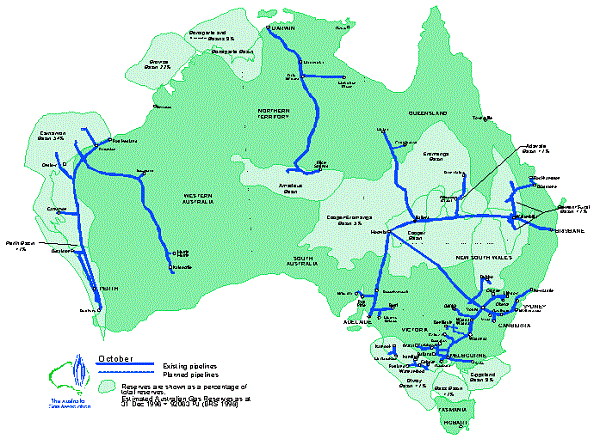
It’s a long way from the Surat Basin in Queensland to any big cities in southern states.
If all goes well a final investment decision on the IG Partners proposal could be made by the end of 2017 with a power plant ready for commissioning by late 2020. Presumably it would be additional to Weatherill’s proposed 250MW gas-fired power station which is conceived as standby power. Weatherill does want to make SA more independent on electricity, and the list of SA power stations contains Torrens Island, a 1280MW gas-fired facility over 50 years old, due for mothballing and which partly failed just before the lights went out in February.
South Australia’s dependency on gas appears to be the greatest of any state. This graph from AEMO in 2015 shows the situation before and after the closure of their only two coal stations:
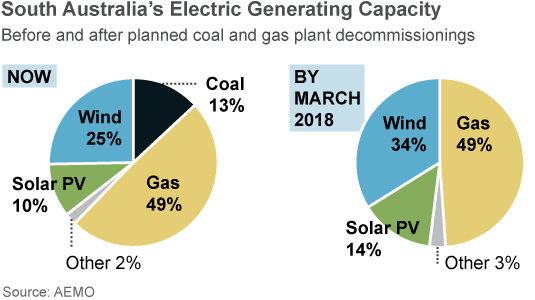
It includes solar PV, but not power sourced from Victoria. This image from the SA energy plan shows the current situation, minus solar PV and Victoria:
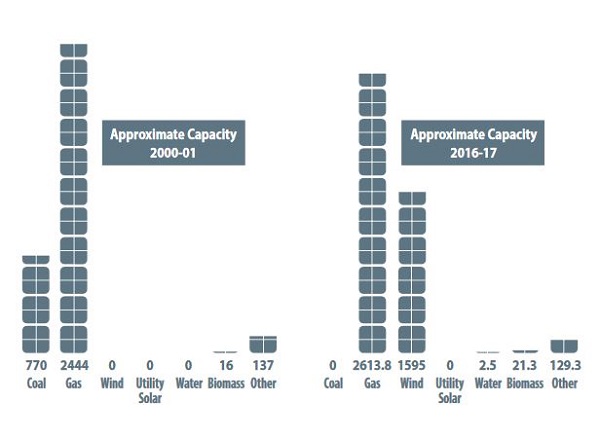
The floating gas hub could stabilise gas prices, and perhaps make the other states think, as well as Dr Finkel and the national plan. I’ll just keep repeating this from Blakers et al in an article of February 7, 2017 where they looked at a 100% renewable energy supply using wind, solar and pumped hydro. They found:
- Using 2016 prices prevailing in Australia, we estimate that the levelised cost of energy in a 100% renewable energy future, including the cost of hourly balancing, is A$93 per MWh. The cost of wind and PV continues to fall rapidly, and so after 2020 this price is likely to be around AU$75 per MWh.
Angela Macdonald-Smith in Cheap gas is a thing of the past and pathetically, insiders knew it was coming gives a brief account of how we got into this mess.
In brief, the coal seam gas industry started out in late 2008, on the eve of the GFC, in a fit of irrational exuberance, ending up with three rival ventures investing a total of $80 billion. A fourth venture between Shell and PetroChina was planned, but pulled out when they saw how things were developing. International gas prices were linked to the price of oil, which everyone knew would keep going up, until it didn’t.
Possibly a bit less than expected was coming out of the ground in Queensland, but the industry did not expect to be stopped at the border by drilling and fracking bans.
Had the companies sold more gas than they had at their disposal?
- Analysts honed in on the volume of gas held within each LNG venture, with Santos’s $US18.5 billion GLNG venture in the spotlight. While Origin’s Australia Pacific LNG project had more than enough, and BG’s Queensland Curtis project would rely on third-party gas for about 5 per cent of its needs, GLNG from the start looked short. Had Santos and its partners, including French oil major Total, [the GLNG joint venture], sold more gas under long-term LNG contracts than they had?
The answer came in October 2010 when:
- Santos announced the sale of 750 petajoules of gas from its core Cooper Basin venture in central Australia to GLNG over 15 years, with then CEO David Knox vaunting the deal as a game changer to unlock the potential of the Cooper and provide “additional strategic advantage” for GLNG.
From that moment today’s predicament became all but inevitable, said one gas industry insider.
- “Over half of Cooper’s uncontracted [proven and probable] reserves at the time – which, along with the Gippsland Basin Joint Venture were the heart of domestic gas supplies – gone, just like that.”
It was around that time the NSW and Victorian governments put the mockers on industry ambitions on their patch.
This is not going to change, although it’s hard to see why the bans extend to conventional gas drilling. However, the world glut in gas is expected to last into the next decade, which would make any new ventures questionable.
In 2012 the Prime Minister’s Manufacturing Taskforce recommended steps to ensure access to gas for domestic users at “fair and competitive prices”. Julia Gillard would have none of it, no doubt advised that the market would take care of everything.
In any case, the bird had flown with the Santos deal. Official denial that anything is amiss has continued until this year, when chief scientist Alan Finkel and the Australian Energy market Operator have announced that we have a problem with gas.
Malcolm Turnbull has said to gas producing executives, fix it or we’ll fix it for you. However, in the commercial world a contract is a contract, and if the government rescinds your ability to fulfill your export contracts, then sovereign risk becomes real.
Meanwhile Ian McAuley, when asked by John Menadue to write about the National Electricity Market, said he found the task difficult because he couldn’t make any sense of the NEM. All split up in bits with chancers able to maximise their profits.
Macdonald-Smith:
- “Surely it is the worst combination of private and public sector incompetence in Australia’s history,” one jaundiced senior industry executive says.
In these circumstances floating gas hubs and buying gas at international prices may not be the silliest thing to do.
Update: Politicians are cheering because Shell announced that it would sell 10% more gas onto the eastern market, thanks to the development of the new Ruby field in Queensland – $500 million and 350 jobs in construction.
That was in the AFR.
Macrobusiness is not impressed, and called it a “fart” on the market. Shell extra 10% will make a grand total of 75Pj. They say we actually need an extra 160-200Pj. Their solution is:
- We need to hold back a tiny 160Pj of gas to balance the domestic market. That amounts to a fantastically paltry 2.9% of total national demand or 3.6% of total export volumes in 2018. 80% of Australian gas production would still go to Asia.
For legibility I’ve split their pie chart of 2012 and 2018 Australian gas market into two images:
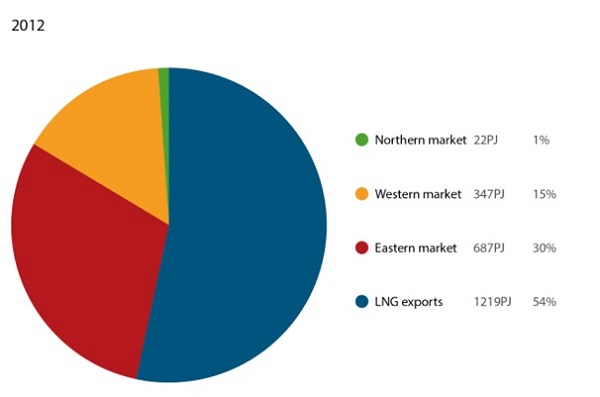
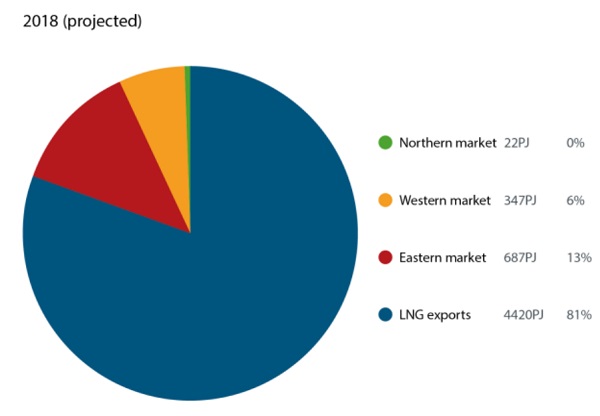
However, the worst is that the whole enterprise was a stuff-up from the outset:
- These same firms and governments lose money on every tonne that they ship offshore. They buggered up their investment metrics so horribly that when you include the cost of capital for building the plants, they are losing money hand over fist. This even includes the west coast LNG plants. As a result they can claim huge depreciation and write-offs on massively inflated investments and they pay no tax.

The positive side of all of that is that the industry has maximised the incentives for individuals to source their own energy from the sun directly. Greed breeds competition.
What I didn’t mention, because I hadn’t researched the detail, is how little the public is getting from selling our gas. Lenore Taylor today on Insiders today put it as $800 million pa, much less that the $26 billion Qatar is getting, and less than the Japanese public are getting from our gas, because their government charges an import duty.
Michael Stutchberry said that was not a fair comparison, because apart from royalties the companies pay tax, and so do the workers, or something.
Some investigative journalism might reveal the true picture, but the general picture is that we are getting bugger all.
It is worth remembering that solar tower power generation with molten salt heat storage and, if needed, backup molten salt heaters has similar characteristics to relatively small coal fired generators and will provide reliable, 24/7 baseload if required.
It is also worth remembering that it takes a lot of energy to liquefy gas and that burning gas to generate electricity is a poor use of this artificially limited resource. Gas should be used for manufacturing industries that cannot replace it with electricity.
I agree with you fully here, JD.
John, on molten salt, I think it’s a matter of what works best pragmatically in any given situation. I keep quoting the Blakers pumped storage study, because they have costed it overall, and found the cost acceptable.
You sent me a link about using seawater for pumped storage (thanks muchly!) which I’ll use in the next CC. It says SA doesn’t have good prospects for pumped storage in general, because of topography and a lack of freshwater. However, they have a few places where saltwater can be used and one is being actively investigated.
Larger scale solar, where they have a turbine combined with molten storage, sounds as though it should be on their agenda, for a balanced power system.
The other thing I wanted to say is that coal seam gas uses a lot of power to extract the gas, because what comes out is gas contained in a salty brine. The brine has to be pumped to a processing plant kilometres away, then the brine has to be cleaned up and disposed of in some way. More power used.
There is also an issue, not fully researched, about ‘fugitive emissions’, gas that escapes during the process.
Gas isn’t as clean as it is made out to be, and methane in its first year in the atmosphere is 100 times more potent than CO2. The figure quoted is usually 20 times, but that is on a 100 year time scale.
Brian
SA Gas proposal may not be what it seems – see Giles Parkinson
South Australia’s plans to install a 250MW gas peaking plant is not what it seems: it now appears the government is looking to install world- first technology that combines gas-fired power with battery storage, a move that could help reshape the state’s energy market.
Energy minister Tom Koutsantonis dropped some hints of what he was looking at in Tuesday’s press conference. (RenewEconomy didn’t pick it up at the time because we had ducked out to talk to ABC Radio on the breaking news of the South Australia energy plan).
Koutsantonis had talked of a gas generator and battery storage, and it was assumed he was talking about the seperate tenders – the peaking gas plant and the 100MW battery storage.
But it turns out Koutsantonis was talking about a gas turbine that has a battery storage unit attached, which means that the turbine can spin without burning fuel – rather like a jet engine on the runway – and can provide instantaneous response to grid faults.
http://reneweconomy.com.au/s-government-eyeing-world-first-gas-plus-battery-storage-units-17332/
Douglas, that’s interesting and important, and I’d missed it so far.
However, it’s about the SA energy plan, not the IG Partners proposal to build a 350MW gas-fired plant with gas sourced from a floating hub. As far as I can see RenewEconomy hasn’t covered that project yet, nor had anyone else when I Googled.
A bit difficult to get a handle on all the proposals floating around. The big announcement on the Snowy was nothing more than a feasibility study. Economics of that will be interesting.
Douglas, Danny Price wrote yesterday that the Snowy thing had the potential to extend the life of coal, because coal can pump the water up at night without competing with cheap solar.
Furthermore, it lessened the chance of private investors developing new renewable power, because it was an ad hoc government intervention in a policy vacuum.
Angela Madonald-Smith in the AFR today:
Estimates are that GLNG will have to source 40 to 50% of the gas it needs for its Gladstone LNG project.
When the Gladstone projects were set up the government approved sourcing from third parties. seemed like a good idea at the time from third parties.
On Monday John Kehoe wrote:
As Prime Minister Malcolm Turnbull was convening an emergency meeting with gas producers last week to fix Australia’s looming “energy crisis”, The Wall Street Journal’s front page splashed with the headline that America’s “Natural Gas Glut Deepens”
The US has plenty of shale gas, and has built up an efficient network covering the country, supplying 320 million people. Coal’s energy share has been reduced from 50% to 31%.
Last year the US started exporting to Canada and Mexico, and now is looking further afield, to become the third largest exporter in the world. their gas is much cheaper than ours, and it’s cheaper to land their gas here than it is for Victoria to get it from Queensland.
You’ll find BHP Billiton owns a goodly slice of US gas production.
I believe the industry got going when George Dubya deregulated fracking.
I’ve done an update to the post on Shell’s happy news that it is going to shovel a bit more gas into the market. Here it is:
Update: Politicians are cheering because Shell announced that it would sell 10% more gas onto the eastern market, thanks to the development of the new Ruby field in Queensland – $500 million and 350 jobs in construction.
That was in the AFR.
Macrobusiness is not impressed, and called it a “fart” on the market. Shell extra 10% will make a grand total of 75Pj. They say we actually need an extra 160-200Pj. Their solution is:
We need to hold back a tiny 160Pj of gas to balance the domestic market. That amounts to a fantastically paltry 2.9% of total national demand or 3.6% of total export volumes in 2018. 80% of Australian gas production would still go to Asia.
For legibility I’ve split their pie chart of 2012 and 2018 Australian gas market into two images:
However, the worst is that the whole enterprise was a stuff-up from the outset:
These same firms and governments lose money on every tonne that they ship offshore. They buggered up their investment metrics so horribly that when you include the cost of capital for building the plants, they are losing money hand over fist. This even includes the west coast LNG plants. As a result they can claim huge depreciation and write-offs on massively inflated investments and they pay no tax.
‘pay no tax’
seems to be a recurring motif with large companies and wealthy individuals in Australia……
Which is a pity.
Ambigulous, it seems we are practically giving our gas away, the main benefit of which is in the balance of payments, and the tax paid by workers, but there are not too many of them when a field is developed.
I’m with John D, who if I understand him correctly, says gas has value as an industrial feedstck, and burning it is essentially foolish.
This article and the lousy 25 cents per tonne paid by WA iron ore producers provides a strong argument for charging the GST on exports that should be benefiting Australia and helping to fund government programs.
Over the mining lobby’s cold dead body 🙂
John
WA voters, that own the iron ore and gas, wouldn’t gain anything due to the Fed GST distribution formula.
Any gains would go to the welfare States, and thats unfair.
Will Mcgowan have the guts to raise royalty levels ?
Probably not, but it’s nice to see Jumpy in agreement with Crikey.
Well, I don’t read crikey so it seems they agree with me coz the obviously read C+.
“The Nationals want to introduce a mining tax that will destroy jobs without delivering any benefits to our State. The tax is a direct attack on our mining industry.
“The policy will cost local jobs but most of the money raised will be sent to the eastern states through the GST. 90 per cent of the money raised would be sent over east to other States under the Liberal-National Government’s GST arrangement.
WA ALP agree with me too.
Since McGowan (in the words Jumpy quotes) was merely echoing the mining lobby’s misrepresentation of Nationals policy we are now confronted with the bizarre spectacle of Jumpy being in agreement with the mining companies, the socialist ALP and the lefty gutter press (swill that it is).
The only person he doesn’t agree with is Brendon Grylls who attempted to get the miners paying a fair price to WA voters, who actually own the iron ore and gas that is being exploited.
Royalties are not a tax so I disagree with McGowans terminology but his GST and ( potential ) job loss points are spot on.
Has he the nads to discuss the royalty levels with his Bosses, the voters ?
Time will tell, I’m not optimistic he will.
Strange to see zoot agrees with Grylls on anything but happy he has the ability.
Honestly zoot, would you have voted Nat if you were eligible in WA based on this very important issue ?
Interestingly Dick Di Nutella and and Macadamia Hanson had almost identical vote %s in the seats they contested.
Looks like 80% in WA have nut allergies.
Being a person of principle who doesn’t just invent stuff or make unfounded assertions, Jumpy will now cite his evidence that I agree with Grylls and give his reasons for describing that situation as strange.
Or will he?
Don’t hold your breath.
Your own words, direct quote.
But there is no ” fair price ” just an optima price to aspire to .
I describe accurately what Brendon Grylls did and according to Jumpy that means I agree with him?
By that reasoning, if I wrote, “Hitler instigated the Final Solution” it would mean I was in favour of the Holocaust.
Logic fail.